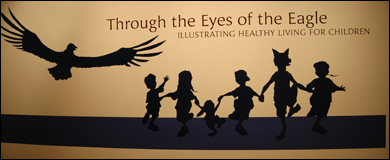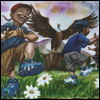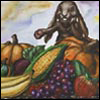Eagle Books Exhibit at Smithsonian Illustrates Healthy Living
 Through the Eyes of the Eagle: Illustrating Healthy Living for Children is on display October 3, 2008 through January 4, 2009 at the Smithsonian's National Museum of the American Indian in Washington, DC and New York, NY.
Through the Eyes of the Eagle: Illustrating Healthy Living for Children is on display October 3, 2008 through January 4, 2009 at the Smithsonian's National Museum of the American Indian in Washington, DC and New York, NY.
The Eagle Books, a series of four children's books, encourage a return to traditional ways, including physical activity and healthy eating. Over 2 million books have been disseminated widely throughout Indian Country, the rest of the US, and abroad.

To expand the reach of these vital health messages, artwork from the Eagle Books is on exhibit at the Smithsonian this fall. Through the Eyes of the Eagle: Illustrating Healthy Living for Children is on display October 3, 2008 through January 4, 2009 at the Smithsonian's National Museum of the American Indian in Washington, DC and New York, NY. Original watercolors featured in the books Through the Eyes of the Eagle and Plate Full of Color are on display in Washington, DC. Artwork from the other two books, Knees Lifted High and Tricky Treats, are exhibited in New York, NY.
American Indians, Alaska Natives and Diabetes
While diabetes affects nearly 24 million people in the US, American Indians and Alaska Natives suffer disproportionately from the disease. In fact, Native American adults are twice as likely as their white counterparts to have diabetes. Young people are also familiar with the devastation of the disease. Children often help care for family members with diabetes, and many children are at risk themselves. Type 2 diabetes, although relatively rare in children, accounts for 76 percent of cases among 10- to 19-year-old Native children. In fact, rates of diabetes among Native people younger than 35 doubled between 1994 and 2004.
Eagle Books
The Eagle Books are a series of four books for Native American children and those interested in healthy living. The stories promote diabetes education and encourage a return to traditional ways, including physical activity and healthy eating. The series was developed by the Centers for Disease Control and Prevention's Division of Diabetes Translation in collaboration with the Tribal Leaders Diabetes Committee and the Indian Health Service in response to the disproportionate burden of diabetes among Native Americans and the lack of diabetes education materials for children.

The books were authored by Georgia Perez, who lives in Nambe Pueblo in New Mexico. In 1994, she began specializing in diabetes education with the Native American Diabetes Project at the University of New Mexico. The stories in the Eagle Books came from a recurring dream of an eagle that showed Ms. Perez "how life for Native Americans used to be and some things that Native people should do to be healthy once again." Through her work with physician Janette Carter, she began developing culturally-tailored educational materials.

Patrick Rolo (Bad River Band of Ojibwe, Wisconsin) and Lisa A. Fifield (Oneida Tribe of Wisconsin, Black Bear Clan) are the illustrators of the Eagle Books. Mr. Rolo draws from his rich heritage to co-illustrate the Eagle Books. His career includes newspaper, magazine, comic book, and court illustration. His fine-art paintings hang in galleries in Minnesota and Washington State. Ms. Fifield uses time-honored Native American tales and beliefs as the inspiration for her work. Her color palette is unique, as she mixes paint to her own aesthetic. Her art has been exhibited in numerous museums in the Western United States.
More Information
- The Eagle Books: Stories about Growing Strong and Preventing Diabetes, learn about the books and ordering information, download free coloring books and a teacher's guide
- The Eagle's Nest, a Web site where kids can learn more about living healthy and diabetes
- Diabetes & Me
- Eagle Books Animated Videos, CDC-TV
- Through the Eyes of the Eagle (
 6:36 mins)
6:36 mins) - Knees Lifted High (
 7:36 mins)
7:36 mins)
- Plate Full of Color (
 8:09 mins)
8:09 mins)
- Tricky Treats (
 10:50 mins)
10:50 mins)
- Through the Eyes of the Eagle (
- Eagle Books Podcasts
- Through the Eyes of the Eagle (
 7:10 mins)
7:10 mins)
- Knees Lifted High (
 8:21 mins)
8:21 mins)
- Plate Full of Color (
 8:13 mins)
8:13 mins)
- Tricky Treats (
 10:28mins)
10:28mins)
- Through the Eyes of the Eagle (


